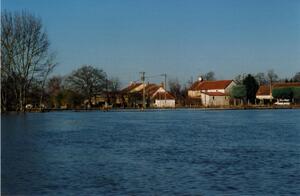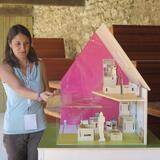- Home
- Resources
- Expériences
- Raising awareness among a generation of schoolchildren of the flooding risk
Raising awareness among a generation of schoolchildren of the flooding risk
Published on 24 August 2017 - Updated 04 January 2021
- 2013
Specialist teaching aids and module
The Maisons de Loire centres have spent more than two decades working in favour of restoring a flood risk culture. They have sought to step up initiatives for schoolchildren, who represent the future of our local areas. As such, they have designed a programme for 10-11 year olds, based on two teaching aids designed by the Fédération des Maisons de Loire – “La Maison inondée” and “HydroLoire” – as well as a tailoring of events to the local area in question. Several thousand youngsters living near the Loire have so far been reached by the campaign.
Background
Raising the awareness of residents in the Loire Valley and around its tributaries regarding the major flooding risk is key to enabling crisis management where everyone acts responsibly and appropriately.
Aims
- Raise awareness among as many pupils as possible about the river’s flows and behaviours and the flooding risks.
- Establish the common foundations of a risk culture.
- Enable pupils to personally relate to the issues thanks to an adaptation to their living environment.
- Communicate around this project to set a positive momentum going on this theme.
Delivery
Scaling up
After a test phase involving 25 classes in 2013, support from the institutional partners (Centre-Val de Loire Regional Council, the Etablissement Public Loire and State) paved the way for a consolidation phase in 2014/2015. Accordingly, 91 final-year classes in primary school benefited from a free awareness module entailing 2 half-days (1 in the classroom and 1 out in the field, near the school) in 2014/15 (schools whose municipality lies in a flood-prone area).
The aim was then to reach 150 classes a year.
Specific teaching aids
Two specially produced tools can be used alongside the event:
- the "hydroLoire" model accurately shows the way high waters can evolve, and their impact on the natural and urban landscape
- the "flooded home" throws into focus the notion of damage and vulnerability in terms of residents and homes
The flooded house
Beyond the "vulnerability of a residential area", it is first and foremost the "vulnerability of residents" that is the primary focus of this tool. Since the intention is to showcase a "flooded" rather than a “flood-prone” home, onlookers are not presented in this instance with a “waterproof home” where the occupants could “protect” themselves in the event of the river breaking its banks.
The main learning outcomes are as follows:
- Make it clear that, over time, humankind has become more vulnerable in their homes.
- Drive home the extent to which modern homes are vulnerable to flood risks and can generate risks for people and the environment alike.
- Show that there are solutions for reducing the vulnerability of people and property in the home, but that these need adapting on a case-by-case basis.
- Clearly demonstrate everything that would facilitate crisis management and a return to normality (non-floodable area, etc.).
- Encourage pupils to work out for themselves how to reduce vulnerability.
- Encourage youngsters to ask themselves questions about their own homes.
- Stress the importance of high water marks.
Outcome and outlook
- Project continued until 2017 with financial support from the Centre Region and the ERDF: 150 classes a year around the Loire and its tributaries, which brings the total number of pupils reached by the end of 2017 to 14,000
- Enabled teachers to work on this theme outside of the module proposed (production of an educational booklet, blog showcasing classwork, etc. ).
- Rooted the project in local areas by tying it in with other initiatives (e.g.: presentation of the Municipal Information Document on Major Risks (DICRIM) or Municipal Protection Plan (PCS) by a local official).



![Nouvelles Renaissance(s] 2023](/var/storage/images/val-de-loire-refonte/dossier-de-parametrage/pied-de-page/nouvelles-renaissance-s-2023/517479-13-fre-FR/Nouvelles-Renaissance-s-2023_image_largeur220.png)


 Lettre d'information
Lettre d'information
 Facebook
Facebook
 Flickr
Flickr
 Podcloud
Podcloud
 Dailymotion
Dailymotion
 Box
Box
 Slideshare
Slideshare
 Diigo
Diigo

